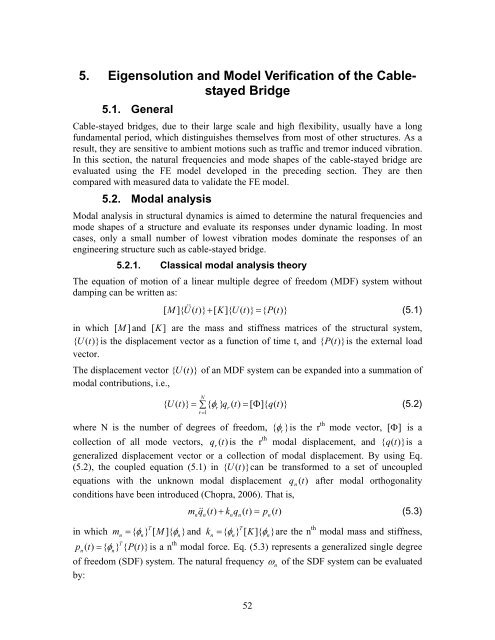Assessment of the Bill Emerson Memorial Bridge - FTP Directory ...
Assessment of the Bill Emerson Memorial Bridge - FTP Directory ...
Assessment of the Bill Emerson Memorial Bridge - FTP Directory ...
- No tags were found...
Create successful ePaper yourself
Turn your PDF publications into a flip-book with our unique Google optimized e-Paper software.
5. Eigensolution and Model Verification <strong>of</strong> <strong>the</strong> Cablestayed<strong>Bridge</strong>5.1. GeneralCable-stayed bridges, due to <strong>the</strong>ir large scale and high flexibility, usually have a longfundamental period, which distinguishes <strong>the</strong>mselves from most <strong>of</strong> o<strong>the</strong>r structures. As aresult, <strong>the</strong>y are sensitive to ambient motions such as traffic and tremor induced vibration.In this section, <strong>the</strong> natural frequencies and mode shapes <strong>of</strong> <strong>the</strong> cable-stayed bridge areevaluated using <strong>the</strong> FE model developed in <strong>the</strong> preceding section. They are <strong>the</strong>ncompared with measured data to validate <strong>the</strong> FE model.5.2. Modal analysisModal analysis in structural dynamics is aimed to determine <strong>the</strong> natural frequencies andmode shapes <strong>of</strong> a structure and evaluate its responses under dynamic loading. In mostcases, only a small number <strong>of</strong> lowest vibration modes dominate <strong>the</strong> responses <strong>of</strong> anengineering structure such as cable-stayed bridge.5.2.1. Classical modal analysis <strong>the</strong>oryThe equation <strong>of</strong> motion <strong>of</strong> a linear multiple degree <strong>of</strong> freedom (MDF) system withoutdamping can be written as:[M ]{ Ut &&()}+[K]{ Ut)} ( = {P(t)} (5.1)in which [M ] and [K] are <strong>the</strong> mass and stiffness matrices <strong>of</strong> <strong>the</strong> structural system,{ Ut)}is ( <strong>the</strong> displacement vector as a function <strong>of</strong> time t, and {P( t)}is <strong>the</strong> external loadvector.The displacement vector {U( t)} <strong>of</strong> an MDF system can be expanded into a summation <strong>of</strong>modal contributions, i.e.,N{U( t)} = ∑{φ r}q r(t) = [Φ]{q(t)} (5.2)r=1where N is <strong>the</strong> number <strong>of</strong> degrees <strong>of</strong> freedom, {φ r}is <strong>the</strong> r th mode vector, [Φ] is acollection <strong>of</strong> all mode vectors, qr ( t) is <strong>the</strong> rth modaldisplacement, and {q( t)}is ageneralized displacement vector or a collection <strong>of</strong> modal displacement. By using Eq.(5.2), <strong>the</strong> coupled equation (5.1) in {U( t)}can be transformed to a set <strong>of</strong> uncoupledequations with <strong>the</strong> unknown modal displacement q n(t) after modal orthogonalityconditions have been introduced (Chopra, 2006). That is,mq&& () t + k n n nq()nt = p n() t (5.3)in which m { } Tn= φn[ M]{ φ n} and k { } Tn= φn[ K]{ φ n} are <strong>the</strong> n th modal mass and stiffness,p n() t = {φ n} T { P()t }is a n th modal force. Eq. (5.3) represents a generalized single degree<strong>of</strong> freedom (SDF) system. The natural frequency ω n<strong>of</strong> <strong>the</strong> SDF system can be evaluatedby:52
















